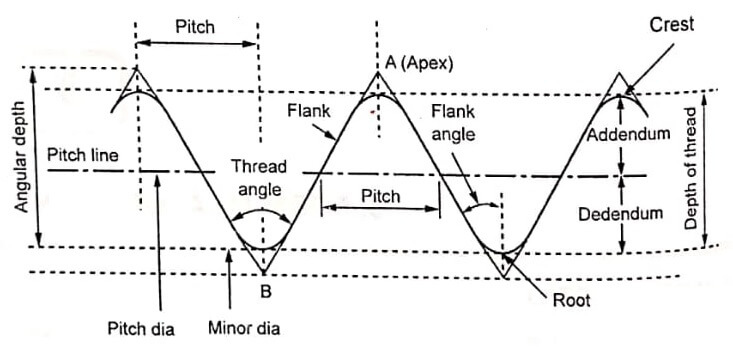Form measurement includes screw threads measurement, gear measurement, radius measurement, surface finish measurement, straightness measurement, flatness and roundness measurements.
Introduction Measurement of Screw Threads
Measurement of screw threads are used to transmit power and motion and also used to fasten two components with the help of nuts, bolts and studs. There is a large variety of screw threads varying in their form, by included angle, head angle, helix angle etc. The screw threads are mainly classified into 1) External thread 2) Internal thread.

Screw Thread Terminology
Screw thread : It is a continuous helical groove of specified cross section produced on the external or internal surface.
Crest : It is the top surface joining two sides of thread.
Flank : It is the surface between crest and root.
Root : The bottom of the groove between the two flanks of the thread.
Lead : Lead = number starts x pitch
Pitch : The distance measured parallel to the axis from a point, on a thread to the corresponding next point.
Helix angle : The helix is the angle made by the helix of the thread at the pitch line with the axis.
Flank angle : Angle made by the flank of a thread with the perpendicular to the thread axis.
Depth of thread : The distance between the crest and root of the thread is called depth of thread.
Included angle : Angle included between the flanks of a thread measured in an axial plane.
Major diameter : It is the diameter of an imaginary co-axial cylinder which would touch the crests
of external or internal thread.
Minor diameter (Root diameter or Core diameter) : It is the diameter of an imaginary co-axial cylinder which would touch the roots of an external thread.
Addendum : For external thread, it is the radial distance between the major and pitch cylinders.
For internal thread, it is the radial distance between the minor and pitch cylinder.
Dedendum : For external thread, it is the radial distance between the pitch and minor cylinder.
For internal thread, it is the radial distance between the major and pitch cylinders.
Error in Thread
The error in screw thread may arise during the manufacturing or storage of threads. The error either may cause due to the following six main elements in the thread.
- Major diameter error
- Minor diameter error
- Effective diameter error
- Pitch error
- Flank angles error
- Crest and root error
Major diameter error – It may cause reduction in the flank contact and interference with the matching threads.
Minor diameter error – It may cause interference, reduction of flank contact.
Effective diameter error – If the effective diameter is small the threads will be thin on the external screw and thick on an internal screw.
Pitch error – Pitch error is defined as the total length of thread engaged either too high or too small. The various pitch errors may be classified into
- Progressive error.
- Periodic error.
- Drunken error.
- Irregular error.
Progressive error : The pitch of the thread is uniform but it is longer or shorter to its nominal value and this is called progressive error.
Causes of progressive error :
- In correct linear and angular velocity ratio.
- In correct gear train and lead screw.
- Saddle fault.
- Variation in length due to hardening.
Periodic error : Periodic errors are repeated itself at regular intervals along the thread.
Causes of periodic error:
- Un uniform tool work velocity ratio.
- Teeth error in gears.
- Lead screw error.
- Eccentric mounting of the gears.
Drunken error :
Drunken errors are repeated once per turn of the thread in a Drunken thread. In Drunken thread, the pitch is measured parallel to the thread axis. If the thread is not cut to the true helix, the Drunken thread error will be formed.
Irregular error : It varies in irregular manner along the length of the thread.
Irregular error causes:
- Machine fault.
- Non-uniformity in the material.
- Cutting action is not correct.
- Machining disturbances.
Effect of pitch error:
- It increases the effective diameter of the bolt and decreases the diameter of nut.
- The functional diameter of the nut will be less.
- It reduces the clearance.
- It increases the interference between mating threads.
- See More : Definition of metrology
- See More : Systematic and random error in measurement
- See More : Errors in measurement
- See More : Metric system of measurement






